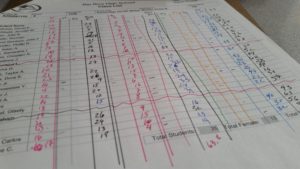 |
How to Grade Efficientlyand Promote Assignment Completion
Grading papers is one of the most time-consuming responsibilities of teaching. Hours upon hours can be, I argue, wasted, pouring over daily homework assignments. This article will discuss how to integrate awarding credit for daily assignments in a way that saves hours of time while increasing your awareness of student progress, increases student completion rates and better informs students regarding their progress in the subject. |
| This routine described here is a daily variety, not how I grade quizzes, tests or projects. However, there are some tips that apply to recording those grades later in this article.
Let’s begin with a question: What is the purpose of homework? For me, it’s practice needed for students to gain proficiency. Homework is about trying things, working out how to struggle through difficult problems and making, and learning from, mistakes. Without effective homework, students will not integrate their learning into a body of knowledge that they can draw upon for application or just recall. The breadth of the purpose of homework and how that purpose is best served is beyond the scope of this article, but I would like to suggest that homework is something done in their notes, whenever possible. The reason being is that notes are a receipt of their learning, to be reviewed in the future to help remember observations and important facts. Overview of How It Works: At the beginning of class, often before the bell rings, I begin walking around the classroom stamping homework that deserves full credit. (What merits full credit is up to your discretion, but it should be a clear and consistent expectation, known to students.) As I circle the room, I look for common mistakes, ask kids if they have questions or difficulties and make small talk. Students that didn’t do, or complete, the homework have to answer for it on the spot! Then, I simply mark those that did not receive credit for the homework on a student roster I keep on a clip board. (For a video of how this works, visit the link here: ) Quick Notes: This method has students ready for class because they have their notes. They’ve also asked me questions if they had any, so I can begin with meaningful review. I also have forced students that are remiss to account for their actions and done so in a way that applies positive peer pressure. The scores are recorded by leaving blanks for completion and only marking those that do not get credit (which will be very few). Credit: I award full credit or zero credit when checking homework. If a student attempted all problems, with evidence of attempt demonstrated by work shown and questions written, they get full credit. Those that fail to receive full credit have the opportunity to reclaim 80% (the percentage is arbitrary but again needs to be consistent, clear and known by all), the students must see me during tutoring time by the Friday of the week of the assignment to show that they’ve fulfilled the expectation. Students that did not attempt the homework can also see me during tutoring time (before or after school, not between class times or lunch), and receive partial credit. But the rule of being due the Friday of the week assigned is big. The purpose of homework is practice. Without proper practice skills and knowledge are not developed. Homework is not about compliance and fulfilling an expectation with a grade as a reward. Students that are hustling to complete homework from two months prior are likely not promoting their understanding of current materials. Plus, by having the time requirement applied to the homework policy, students are not enabled to fall too far behind. The added bonus is that you will not be buried with make-up work the last week before grades are due to be reported! Work to be Turned In: If the nature of the work is not something that can be kept and must be turned in, have the students pass their work forward by row. As you collect each row’s stack, count them. If a row’s stack is incomplete, ask who in the row didn’t turn in the work. If students can NOT fulfill the expectation and only receive a bad grade from it, and that reprimand comes well after the unwanted behavior, they will quite happily go along thinking nothing bad is going to happen. Having to answer, publically, for their lack of work, especially when the vast majority will work, is a powerful deterrent! Just as when checking the work of students and asking those who failed to complete for an explanation, this keeps them accountable and will increase the amount of students completing their work. When collecting the papers, alternate the direction of the stacks and do not mix them up when grading. This will allow you to quick return the papers after you’ve been done. If it is a daily practice type of work turned in, I’d suggest awarding full or no credit and only recording, again on the printed class roster, those that were awarded no credit. Recording Grades: Whether you’ve collected daily practice or are carefully grading quizzes and tests, how you record those grades can either waste your time, or greatly reduce the amount of time spent.
By following this method, the data entry side of grading is done in a few moments of time instead of over hours, working through those stacks of papers, again! Final Thoughts: By looking at, and discussing, homework with students on an individual basis, very briefly, you gain insight into their progress. They get a chance to ask questions. Students that need a little bit of motivation receive it as an immediate consequence for poor behavior, rather than waiting until the end of the quarter, when a lot of pressure will be placed on you to help them bring up their grades. This routine has proven to be a cornerstone of my classroom management. It gives me a way to set the expectation that we are here to learn and that learning is done through work and reflection. Students that need discipline receive it immediately and in a way they find uncomfortable, but it is done so with an invitation that guides them to the desired behavior (of completing their work). |
|

 By recording each grade as it is calculated by hand on the student roster it is quick and easy to transfer them to the computer. This is a huge time-saving practice. You don’t need to hunt on the computer screen for each student, and do so for each assignment. When they’re recorded by hand, you can simply enter the column of numbers in the computer. When the last name lines up with the last number that you entered, you know they’re all entered correctly.
By recording each grade as it is calculated by hand on the student roster it is quick and easy to transfer them to the computer. This is a huge time-saving practice. You don’t need to hunt on the computer screen for each student, and do so for each assignment. When they’re recorded by hand, you can simply enter the column of numbers in the computer. When the last name lines up with the last number that you entered, you know they’re all entered correctly.

